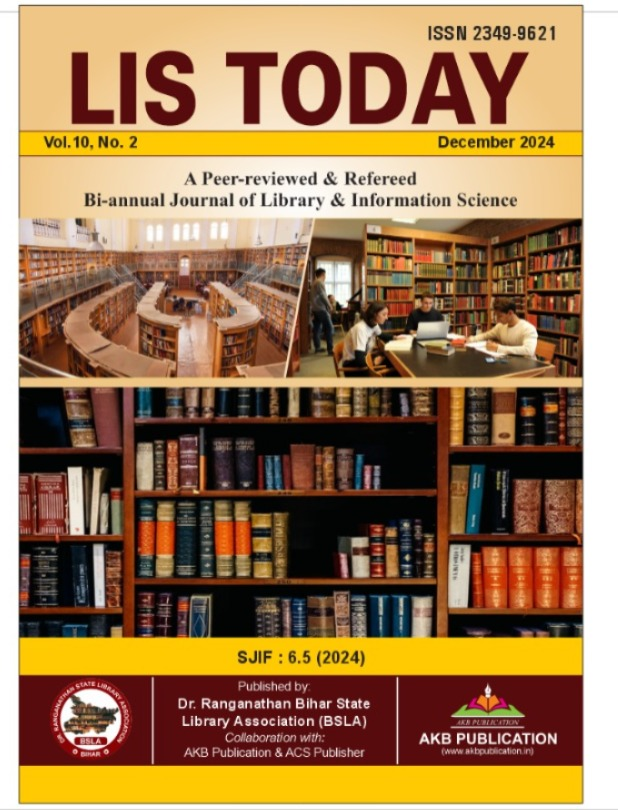Assessing the Information Needs and Seeking Behavior of Women Faculty Members in PU Colleges of Kalaburagi District, Karnataka: A Gendered Perspective
DOI:
https://doi.org/10.48165/lt.2024.10.3Keywords:
Grey literature, Citation analysis, Information utilization, Unpublished Research, Social science, Academic resources, AccessibilityAbstract
This study explores the information needs and seeking behaviors of women faculty members working in pre-university (PU) colleges in the Kalaburagi district of Karnataka, India. Utilizing a mixed-methods approach, the research investigates the primary sources of information, satisfaction levels with library services, and the impact of socio-demographic factors on information-seeking behaviors. The study reveals significant disparities in access to and use of digital resources, influenced by factors such as age, marital status, and educational background. The findings highlight the critical need for enhanced library services, tailored training programs, and policy interventions to support women faculty in their academic and research activities. These insights contribute to the broader discourse on gender and technology in educational settings, emphasizing the importance of equitable information access in promoting gender equality in STEM fields.
References
Abbonato, D., Bianchini, S., Gargiulo, F., & Venturini, T. (2023b). Questioning the impact of AI and interdisciplinarity in sci ence: Lessons from COVID-19. arXiv (Cornell University). https://doi.org/10.48550/arxiv.2304.08923
Amanda, C., Prijana, P., & Yanto, A. (2017). Hubungan perilaku pencarian informasi perempuan dengan kebutuhan fashion. Baca, 38(2), 99. https://doi.org/10.14203/j.baca.v38i2.319
Azadeh, F., & Ghasemi, S. (2015). Investigating information-seek ing behavior of faculty members based on Wilson’s model: Case study of PNU University, Mazandaran, Iran. Global Journal of Health Science, 8(9), 26. https://doi.org/10.5539/ gjhs.v8n9p26
Gabriela, F. (2023). Students’ information seeking behavior and information needs. Revista Română De Biblioteconomie Şi Ştiinţa Informării, 19(1), 1–12. https://doi.org/10.26660/ rrbsi.2022.19.1.01
GH, H. K., & Jagannath, U. (2019). Information seeking behaviour of faculty members of agricultural universities
in Karnataka: A case study. IP Indian Journal of Library Science and Information Technology, 4(1), 19–24. https:// doi.org/10.18231/j.ijlsit.2019.007
Habiba, U., & Islam, M. E. (2022). Assessing the quality and credibility of scholarly information resources: An inves tigation into information behaviours of university faculty members. The Electronic Library, 40(3), 237–255. https:// doi.org/10.1108/el-03-2021-0069
Khan, G., & Bhatti, R. (2012). Information needs and seeking behavior of law faculty members: A survey of the University of Peshawar and its affiliated law colleges. Library Philosophy and Practice. http://digitalcommons.unl.edu/
cgi/viewcontent.cgi?article=1899&context=libphilprac Kumar, P. (2013). Information seeking behaviour of faculty members at BPS Mahila Vishwavidyalaya, Khanpur Kalan (Sonipat) India. Pearl - A Journal of Library and Information Science, 7(1), 1. https://doi.org/10.5958/j.0973-7081.7.1.001 Laleh, J., Mehdi, T. S., & Khosro, K. K. (2014). Determining the information needs of faculty members and post-grad uate students at Rehabilitation Faculty of Shahid Beheshti Medical University-2011(1390). Tibb-i Tavānbakhshī, 3(1), 42–50. https://doi.org/10.22037/r.m.v3i1.6153
Mukarambi, P., & Kohinoor, V. (2022). A study on information seeking behavior of newspaper journalists in Kalaburagi. Research Review International Journal of Multidisciplinary, 7(1), 53–57. https://doi.org/10.31305/rrijm.2022.v07.i01.007
Rostami, C., Hosseini, E., & Saberi, M. K. (2021). Information seeking behavior in the digital age: Use by faculty members of the internet, scientific databases, and social networks. Information Discovery and Delivery, 50(1), 87–98. https:// doi.org/10.1108/idd-02-2020-0014
Sharad, A. T. (2022). Information-seeking behavior of aca demic library users. Journal of Library and Information Communication Technology, 11(2), 96–103. https://doi. org/10.5958/2456-9399.2022.00019.0





